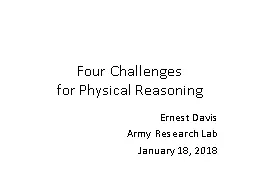

Ernest Davis Army Research Lab January 18 2018 4 challenges Reasoning beyond simulation Integrating highlevel planning with robotics Physical reasoning in language understanding Science and commonsense physical reasoning ID: 791117
Download The PPT/PDF document "Four Challenges for Physical Reasoning" is the property of its rightful owner. Permission is granted to download and print the materials on this web site for personal, non-commercial use only, and to display it on your personal computer provided you do not modify the materials and that you retain all copyright notices contained in the materials. By downloading content from our website, you accept the terms of this agreement.
Slide1
Four Challenges for Physical Reasoning
Ernest Davis
Army Research Lab
January 18, 2018
Slide24 challenges
Reasoning beyond simulation
Integrating high-level planning with robotics*
Physical reasoning in language understanding*
Science and commonsense physical reasoning
* I don’t actually work on these
Slide3Reasoning beyond Simulation
Overwhelmingly, physical calculations rely on time-step simulation:
t
= 0;
S(0) =
initialState
;
repeat {
S(t+
Δ
)
= extrapolate(S(t),
Δ
);
t
=
t+
Δ
;
} until (done)
Monte Carlo simulation
Scientific computing, CGI, games
Slide4Simulation is Insufficient
Incomplete knowledge:
An enemy robot is coming at you. You need to judge what it can and can’t do. E.g. it probably can’t teleport past a wall.
No models
W
hat would happen: If you try to cut wood with a scissors? If you try to cut your hair with a lawn mower?
Slide5Choosing an idealization
Bob is: String is:
A point mass Value for distance
A rigid object Bound on distance
Non-rigid object 1D curve
3D object
Slide6Incorporating extra-physical information
If you see a pitcher throwing a ball, it will almost certainly end up inside or just outside the strike zone.
Slide7Simulation is overkill
Rapidly drawing easy inferences
If
you chop an iPhone in two with an axe, it won’t work any more
.
If you blow up the attacking robot with a grenade, it will probably cease to attack.
If you are riding a bike on a bumpy road, and you have water in a closed canteen, it stays in the canteen.
If a jar fits on a shelf empty, it will still fit once you have filled it with pennies
.
Slide8Alternatives to simulation
Machine learning
Knowledge-based reasoning
Qualitative reasoning
Reasoning by analogy
Slide9High-level planning and robotics
Ghallab,
Nau
, and
Traverso
,
Automated
Planning: Theory and Practice
(2004)
LaValle
,
Planning Algorithms
(2006)
Slide10Planning and robotics
In general, planning across levels of abstraction is hard, but this gap seems particularly large.
Richer symbolic models of action and perception
More powerful techniques for high-level reasoning about continuous spaces.
High-level robotic languages
Slide11Physical reasoning and language
“The trophy didn’t fit in the suitcase because
it
was too [small/large].”
“I pushed a pin into a carrot. When I pulled out the pin,
it
[left/had] a hole
.”
“I tried to push the button through the hole, but
it was too [large/small]”
“I forgot that the top button was fastened, so when I took off the coat,
it
tore off.”
Slide12Physical reasoning and language
“In allopatric speciation, gene flow is interrupted when a population is divided into geographically isolated subpopulations. For example, the water level in a lake may subside, resulting in two or more smaller lakes that are now home to separated populations (see Figure 24.5a). Or a river may change course and divide a population of animals that cannot cross
it.”
(Campbell,
Biology)
.
Slide13Physical reasoning and language
Many dogs, they say, are the death of a hare, a single dog cannot achieve it, even one much speedier and more enduring than Bashan. The hare can “double” and Bashan cannot — and that is all there is to it. . . . The hare gives a quick, easy, almost malicious twitch at right angles to the course and Bashan shoots past from his rear. Before he can stop, turn around, and get going in the other direction, the hare has gained so much ground that it is out of sight.
—
“A Man and his Dog”, Thomas Mann
Slide14Physical reasoning and language
Semantically deep representations of text
Knowledge base of physical knowledge
Integrate knowledge into
text understanding
Slide15Science and commonsense reasoning:Understanding the relation of the equations to the real world
Equation
Realia
Scales Falling Objects
Solar system Tides
Slide16Measuring the gravitational constant
Slide17You can’t start at the foundational equations
We know that [the
Schr
ö
dinger
equation for electrodynamics] is
correct. … But
it cannot be solved accurately when the number of particles
exceeds
about 10
. .
It is possible to perform
approximate calculations
for larger systems, and it is through such calculation that
we have
learned why atoms have the size they do, why chemical bonds
have the
length and strength they do, why solid matter has the elastic
properties it does, why some things are transparent while others reflect or absorb light … But the schemes for approximating are not first-principles deductions but are rather art keyed to experiment.Laughlin and Pines, “The Theory of Everything”
Slide18Lagrangian for Standard Model of
Particle Physics
First 10 lines of 36:
Slide19Physics: Theory and Reality
Multiple theories at different levels of description
Rich representation at the human scale
Characterization of informal arguments:
Approximation, abstraction, idealization, closed world assumption, ignoring irrelevant issues and small quantities.
Slide20Thank you!